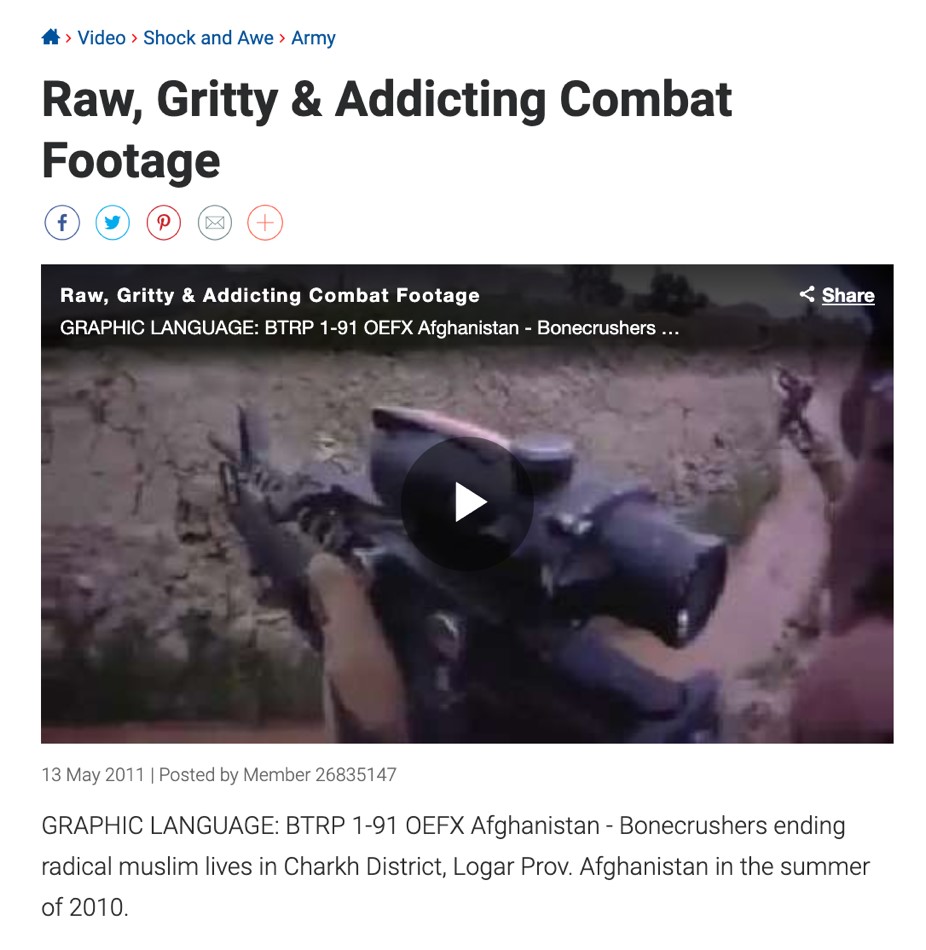The proliferation of “action cameras” (e.g., GoPros) on the battlefield has made possible a newly kaleidoscopic first-person vision of warfare. Gore and war have been staples of underground and mainstream video for a long time; what’s changed is not necessarily the degree of public interest in such content, but rather the ease of capturing it at the source and distributing it widely. Thanks to content channels like YouTube, Reddit, and the anything-goes LiveLeak, efficient dissemination of combat footage is now readily available to combatants and observers on all sides of a conflict. Sensational and slickly edited propaganda video (of the kind that ISIS is fond of) mingles with starker visions of war—sometimes banal, sometimes astonishing. In certain darker corners of the Internet, dramatic and disturbing videos of military clashes have attained a perverse kind of infamy.
Unsurprising, of course, that people would be fascinated by the stakes and the spectacle of warfare. I’m more interested in what indulgence of this interest and long-term exposure to this content does to the psyche. The chance to see through a combatant’s eyes, more or less, has a twinned effect: humanization, in the way that frustration, fear, and horror are rendered more palpable and immediate so that the average soldier can be empathized with; and disassociation, in that the distancing of the screen can render warfare into entertainment. It has long been a common refrain of media criticism that our cultural obsession with violence risks desensitization, that we may become inured to war’s true horror. There is some convincing empirical evidence attesting to this effect. Communities like Reddit’s r/combatfootage that have sprung up around such videos make possible a relentless exposure to thousands of hours of first-person death. Viewers who are merely indulging some morbid curiosity might feel the human weight of these moments. Yet someone chronically exposed to these kinds of videos and driven to catch glimpses of gore might feel nothing at all.
…viewing of violent movies led to increased depressive and anxiety symptoms that diminished with repeated exposure (Linz, Donnerstein, & Penrod, 1988), as well as less empathy and sympathy for the depicted victims (Fanti, Vanman, Henrich, & Avraamides, 2009; Mullin & Linz, 1995). Behavioral measures of desensitization also showed slower helping responses in children, college students, and adults after exposure to violent videos or videogames.

Or worse. It’s not unreasonable to suspect that a sort of hedonic treadmill for extreme content exists. But the Internet’s vast archives of combat video, in tandem with its interactivity, have engendered an effect more sinister than a mere accustomization to violence, or a failure to treat it with due gravity. It instead precipitates an active fetishization of the act of killing—particularly in the name of national pride. Riled-up citizenries since time immemorial have bayed for the blood of the enemy, and video has served the purposes of propagandists for as long as the technology has existed. Nations, in particular the more imperial among them, have always sought to wow their own citizens with their military capability. But only recently have the bloodthirsty been afforded the chance to witness in detail and obsess over the objects of their lust. Here, we see a reversal of the propaganda model—rather than the sanitized and ideologically inflected artifice of the war film, we have the real thing close-up on camera, to which viewers bring their own predispositions.

WarWatchers.com
What of the online communities that collect and salivate over these videos? What to make of the men (and, according to site demographics, they are largely men) who fetishize not only the technology of war but its bloody products? They seem to experience not so much a habituation as a more comprehensive reorientation of moral values. I read through thousands of responses to war videos in an attempt to take the pulse of commenters’ attitudes toward graphic content. I found that—while they commonly make passing nods to sentiments along the lines of “war is hell”—such reflection is usually takes a backseat to discussions of the technical minutiae of weapons systems, the heroism and tactical merits of a preferred force, or the thoroughness of a “kill.”
Though it’s an apt descriptor, I place “kill” in quotations because, in the context of these forums, the way it’s deployed tends to implicitly tokenize, to dehumanize. This choice of diction makes the corpses of human beings into the products of a hunt. I read a nonchalant comment chain discussing the exact process by which an ISIS fighter died onscreen—what it meant, anatomically, that the man gurgled and gasped before collapsing. He was choking on his own blood after taking a round to the lungs. Elsewhere I found a dispassionate observation that the clear liquid spurting from an Iraqi man’s nostrils as he was executed with a shot to the back of the head was in fact cerebrospinal fluid. These are not the kind of things that it is healthy to view repeatedly—at least, without a strong core of empathy and an appreciation of the stakes. It’s certainly alarming to come across comments that indicate the glee that many derive from these scenes.

Yet glee is, in these online spaces, all too common. I believe that it’s possible to link this shift from desensitization to glorification to the advent of certain media technologies. The resemblance of very real first-person warfare to very artificial first-person shooter games is uncanny. In a typical combat video, a weapon juts from the bottom of the frame. Men fall and die in weeds and sand and mudbrick houses. It’s the exact kind of spectacle that has attracted so many to video gaming—vicarious thrills administered out of harm’s way. There is a glut of horrifying footage from Syria; other clips show everything from the Chechen conflict to the French Foreign Legion. Turkish attack helicopters fire on a crowd of civilian protesters during the 2016 coup attempt. FSA fighters hit an SAA tank with a rocket; smoke pours from the cannon and burned men crawl out, ragged flesh where limbs should be. Another video shows US troops as they are fired on and killed by their own tank. One soldier dies as others try to comfort him; it’s censored, but they can’t pixelate away all of the blood. (The US government still does their best to censor any images of dead or dying American soldiers and prevent them from propagating across the Internet). Another American soldier is simply gone. There’s no glory to be found here, just an utterly grim senselessness. Steeping for a few hours in the cold fear and raw horror on display by fighters on all sides left me unsettled to an extent that is almost always, mercifully, unreached in the course of my daily experience.
Maybe worst of all are the grainy FLIR aircraft videos—not because of their gore, exactly, but moreso for their disproportionality. Shot at great remove, they provide an isometric aerial vantage point as missiles tear apart unsuspecting groups of people on the ground. The targets are almost always dressed in civilian clothing—who’s to say whether they were “the enemy” that their destruction presupposes? But there’s no time for such considerations. Hearing the projectile, the targets inevitably attempt to flee no more than a second before impact. It’s futile; their last act only serves to evidence that they died in extreme fear. The infrared vision renders all heat in white. When people are destroyed, ropes and splashes of glowing white viscera are splayed across the dirt.
Call of Duty: Postmodern Warfare
One of the most disturbing examples of such is the infamous Chelsea Manning-leaked “Collateral Murder” video, where an attack helicopter crew laughs as they slaughter Reuters journalists—but it’s far from the only one. That egregious footage was suppressed. But the US military often posts other gun’s-eye-view recordings to revel in the destruction of their professed enemies. ‘Shock and awe’ isn’t intended only for enemy combatants. In an uncanny simulacrum, Call of Duty replicates the three-quarter view and stark monochrome of the airborne gunship camera to the point where it’s practically indistinguishable from real footage. In general, the Call of Duty games are parodic, mawkish representations of combat, where the main attraction is the spectacle of violence and weaponry.
If we’ve become indurated to stylized fictional bloodshed over the years, what does it mean to become desensitized to the actual horror from which action movies and games so cartoonishly bowdlerize their conflict and drama? To even come to clamor for it? What does it mean that a not-insignificant cohort of Internet users has come to prize this content and cheer on its bloody consequences? There is a powerful and vicious cycle at play: our natural curiosity and interest in drama and violence might establish the psychological market for these videos, but the product has been pushed by various interests to the extent where the spectacle now manufactures its own necessity.
As is their wont, nations and interest groups mine and broadcast this content (fictional and real) for their own purposes. This propagandistic cultural superstructure enters into a dialectical relationship with our own worst tendencies and dark curiosities. This feedback loop drives combat and violence to the top slot of entertainment. Concurrently, techno-fetishization both feeds into and is itself fed by an obsession with war and war machines. The proliferation of such attitudes in society and in media then amplifies the initial drive to seek out this kind of stimulation, until the response precedes the stimulus. Consent is manufactured. The populace is psychologically prepared for future large-scale violence.
The Military Desensitization Complex
I can personally speak to one particular line of thinking that helps give rise to this phenomenon. I took an overwhelming childhood interest in aircraft of all kinds. Some kids have fire trucks or dinosaurs; I had planes and helicopters. A huge number of the world’s aircraft designs are, of course, military in origin. Their technical achievements and my boyhood naiveté blinded me to the geopolitical context in which these aircraft exist—indeed, why they exist at all. Now, my view of them has soured, to put it lightly. While there remain trace vestiges of the awe that I felt as a child, these days, I can’t look at combat aircraft without feeling disgust at what I know what these machines really do—what they do to the combatants fighting against them in a mismatched and unjust war, to the civilian men and women and children that die horribly when military power is applied, as it so often is, indiscriminately.
War machines are, in a word, repugnant. Beyond the immediate horror, I have gained an understanding of what the war industry does to our world at large, potentiating conflict, serving as the commodities of the profiteering war racket, and by their mere existence fomenting bellicose attitudes and a readiness to visit death upon foreign populations. I have come to take the same attitude towards movies and videogames and depictions of war of all kinds. I don’t countenance the eye-rolls and dismissals that “it’s just a movie, it’s just a game, it’s make-believe.” These media properties have real connections to real injustice. It is impossible for them to be neutral and for their psychological reception to be confined purely to the realm of entertainment. This is doubly true of footage of actual conflict. Yet our world is absolutely inundated with these media. Big-budget movies and videogames obsessively replicate the fine details of weapons systems and stage innumerable conflicts real and imaginary. Exploring how this all fits into American gun culture and the epidemic of shootings is outside the scope of this article, but suffice it to say, the connections are inextricable.
We live in a culture that abhors ambiguity and nuance. Does someone raised on a diet of propagandistic Western war entertainment (as all Americans are, at least through osmosis) simply slot real-world geopolitical actors into the medium’s established framework—the simplistic calculus of good versus evil? We all bring our preconceived notions to bear on the mediated events that we consume. In the moral universe of action media, the dispensation of justice concludes with the death of the antagonist. A victory that does not comprise the total dominance of a clearly defined enemy is considered unsatisfactory. The thoroughness of their destruction is the measure of moral certitude.
It seems an irony that the very videos that have come to represent, for some, a sublime object of ideology are the selfsame footage that should serve to undermine that ideology’s claims to glory. War is a hell; it offers nothing but entropy and pain. On an abstract level, we acknowledge this. But first-person warfare, the unceasing stream of grim footage that issues from the battlefield, represents a spate of incontrovertible evidence that yes, the adages are true, yes, war is hell, but it is more than a hell—it’s an inhumanity that the unexposed cannot begin to conceive of. The trueness of death, of you and your loved ones being torn limb from limb, is a reality lost upon the comfortable. It should be unthinkable to feel any reaction to war but repulsion. Only the little propagandists in our heads could pervert it and portray it as anything but a crime of the highest order. If anything is worth hating, war is. Yet all too often the bulk of my antipathy towards war, its practitioners, and its profiteers fulminates in the realm of the abstract. These images—and the diminished humanity displayed by their online proponents—serve to remind that we must fight the normalization of hate, fear, and violence. Our hatred for war must be felt viscerally—the full measure of our disgust is what it deserves.

Tyler Walicek is the co-editor in chief of Protean Magazine. His work has appeared in Current Affairs, Fog City Rose, The Bay Bridged, Decoder and elsewhere.

